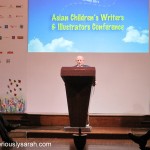The Asian Festival of Children’s Content was on the 26-28 May 2011. I got registered for it and since it did cost quite a bit, here are some highlights and notes from the conferences! It is a literary adventure for this episode. The conferences and workshops were held at the Arts House.
The welcome speech was done by R.Ramachandran, the conference director and it was held at the chamber of the Arts House.
It was a lovely speech and then he introduced Stephen Mooser who presented with the first keynote of the day, What is the Future of Children’s Publishing? It was interesting since he also did talk about ebooks and applications too. Soon, it was time for the concurrent workshops and sessions.
I’ll be writing things down in point form cause there was a lot to learn anyway. Here are some of the sessions I went to.
Author/Illustrator School Visits: Develoing Your Best Programmes by Holly Thompson
- Be prepared.
- Small groups as opposed to doing readings for large halls are more fun and engaging.
- Make sure you have all your tech, as in adapters and powerplugs just in case the place you’re presenting doesn’t have the sort that you have.
- For children, it would be good to have physical items incorporated related to your story to present and show how it works.
- Be fluid and yet try not to freak out!
The Role of an Agent and De-mystifying the Publishing Process, Cradle to Grave by Kelly Sonnack
- Usually 15% commission if you get an Agent. Also, Agent only takes money when you make money. If Agent takes money from you before anything, it is most likely very dodgy.
- Editors from publishing houses send responses to the agent from four weeks, to months or years.
- Agent negotiates a lot with editor and also finalizes a contract. This is much different than the standard contract since they’d know the wording better and want better stuff for the writer too.
- Lots of work Agent does and it’s all for the good of the writer too. All deals are consulted to writer first and then if writer also has any problems with editor etc, Agent helps negotiate.
What was interesting about this session is that it was what some of us were saying about the publishing here, we need agents to even break into the international scene but some people think that it’s unneeded or just an extra when no… It’s not. ANYWHO, this was a very good session and she was a straight to the point and very well spoken presenter!
On Fairies (Diwata), Mousedeers (Sang Kancil), Merpeople, and Magic Spells – Threads that Bind Children’s Tales from Singapore, Philippines, Malaysia and Indonesia by Rhoda Myra Garces-Bascal
- Is not an academic research but more out of passion an interest but the facts were interesting.
- Used Nvivo 9 analysing software
- Singapore’s folktales had a lot of rules, obedience and liked power over love compared to other South East Asian folktales.
- At the end of the talk, feedback from audience, there’s another organization who did this academically and so more info can be found (in pdf form) at http://seameo.org/ !
This session was more of a fun observational sort to know of folktales in SEA. It was pretty fun to know about more stories too and heh, the analyzing was somewhat pretty true too to real life.
Of Power and Emotions: Writing Fiction for Young Adults by Holly Thompson
- Middle grade school is 20,000- 40,000 words
- Young adult is 40,000 – 80,000 words generally (or more!)
- Is usually often an emotional read, fast paced and usually first person narrative.
- YA tends to be concerned with adolescent negotiating his or her place within a social system, learning their place in a power structure.
- “Crossover books” are YA books but it crosses into Adult where audiences from both like the books for example, The Hunger Games.
And then we got to the second day. Didn’t get there so early since the ones that I wanted to attend were later in the day.
Turning Life Experiences Into Fiction by Dianne Wolfer
- Flimsy, cheap notebooks are ok and getting a file to stuff in any ideas you have are good to keep in.
- Stake out a place where you would have your main writing place is. Creating a space gives your credibility that yes, you ARE a writer!
- Think of moments in the past and write about said moments for 3 minutes a day for ideas!
- Adding other senses besides sight, like sound, smell would let the reader feel as if they’re in the story.
- Embarrassing moments are always popular and good to write about in children’s fiction.
- Always take notes.
Ok, there’s so much more but mainly, the latest trend also from all the sessions is that YA is on the rise and that sci-fi and dystopian fantasy are in. Publishers, agents and writers are currently plagued by vampires and that everyone is still confused over the ebook and applications pricing and rights for now.
Eventually, it will be figured out but for now, it’s shaky to know what works and what doesn’t. Mostly, it has to do with the writer’s rights and contracts since if ebooks and apps are out now, what of the future, perhaps there will be other formats and what then?
So hmm, everyone’s going “Woaaaah” on it.
We’ll see how it is, in the future indeed.







Hi! Thanks for posting this – will definitely add this to my list of links.
One other thing, my session on folktales was actually an academic research borne out of passion (haha) I might not have been as clear as I should be – it’s meant to provide an academic lens to what is usually part of humanities/the arts/literature, thus the qualitative software. =)